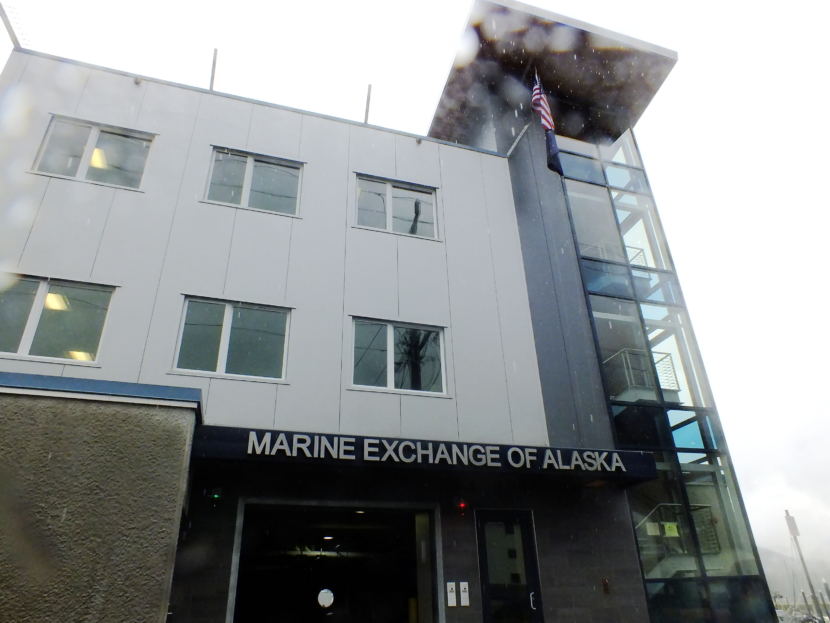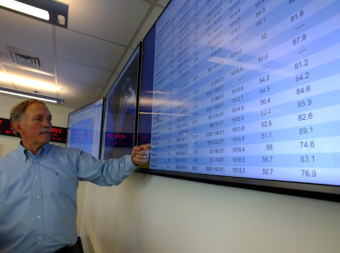
In a new building on the downtown Juneau waterfront, three people are watching rows of large monitors which line the wall of an operations center.
One of the monitors shows the latest marine and weather information from around Southeast Alaska. Another shows an Alaska map with dozens, perhaps even hundreds of colored triangles that represent — in real time — every large vessel traveling through Alaska waters and the Northeast Pacific.
The three-story building adjacent to Harris Harbor is the new location for employees of a statewide vessel tracking system, and it’s not far from their old building.
“Even though it’s only a hundred yards, it’s a big deal,” said Ed Page, executive director of Marine Exchange of Alaska. “I remember myself carrying these some of these servers and ‘I hope I don’t trip in the rain!’”
Page said they kept operating during the recent move, and any related outages probably lasted only for minutes.
“We literally had cables running along the waterfront on the beach, from one (building) to the other to ensure we had never lost any connectivity,” Page said. “Finally, we said ‘OK, we can throw that switch. Now, we’re operating on this side.’ But for a period of time, we had the servers in one building and the operations center in another building.”
It wasn’t ideal to have those servers down for any length of time, especially when they’re used to pull in information from other organizations around the world, like U.S. Coast Guard headquarters and Lloyd’s of London.
Those servers also are used to simultaneously monitor hundreds of vessels in Alaska waters in real time. But Page said they had no other option.

Headquarters and operations center for the Marine Exchange used to be located in the nearby Juneau Electronics building next to the Douglas Bridge.
But Page said they began to outgrow it, and the building’s electrical and air conditioning systems couldn’t handle the load from all of those servers.
He said they began setting aside a portion of their revenue years ago to help pay for their own new $4 million building.
The private, non-profit organization tracks vessels using an automatic identification system, or AIS, box that each ship carries on board. It’s like an aircraft transponder for ships.
The Exchange tracks all of the vessels with nearly a hundred remote tracking stations they have built all along Alaska’s coastline.
The real-time data feeds into the operations center that was mentioned earlier by Page.
The organization has clients ranging from vessel owners to marine pilots, tug operators, cruise lines, tanker operators, and fish processing and shipping companies.
They pay a membership fee to see all the AIS information that comes into the Exchange.
Marine Exchange employees stand watch 24 hours a day, 365 days a year.
If any vessel appears to suffer from mechanical problems or deviates from established traffic routes, then an employee will contact the vessel’s crew to find out what’s happening.

“The fact that you’re monitoring activity influence(s) behavior,” Page said.
Page is referring to extremely risky behavior like exceeding speed limits or straying outside of traffic lanes and getting too close to a dangerous shoreline.
Good information about a vessel’s location also is critical for efficient marine operations.
“Getting cargo off, getting supplies to the vessel, whatever, all dependent when a certain vessel arrives at a certain place,” Page said.
Page used an example of a typical cargo or container ship that that may be coming into port.
“Maybe 10 miles out, the pilot boards the vessel,” Page said. “A couple miles out, a tugboat meets the vessel. And then, closer to the dock, the shore gang, the line handlers show up. And then when it actually docks, the trucks and the cargo movers are there. There’s many different steps. All of that can be much more efficient if you have better information on where the vessel is all the time.”
Nineteen people work at the Marine Exchange of Alaska. Page said their annual budget is over $3.5 million dollars.
An open house of the new building is planned for next Friday and Saturday, Sept. 15 and 16.
